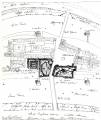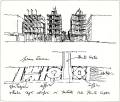Exhibition: The marble ship - Project 2
|
The second project has been proposed by the architect Alessandro Anselmi, with the contribution of Andrea Salvioni and Roberto Ugolini. Find herebelow a short abstract from the author's report of the project; the complete original text (in Italian language) in PDF format can be read clicking on the side picture. (Files .pdf require the installation of Acrobat Reader that can be downloaded for free HERE) ...  In on sense ... planning on the island has to represent a sort of exemplary participation focused on the method of the urban restoration,
apart from a proper compensation to the town. ...
In on sense ... planning on the island has to represent a sort of exemplary participation focused on the method of the urban restoration,
apart from a proper compensation to the town. ...The project for the Tiber island consists of five activities: l) Design-reconstruction of the building on the two banks of the river. ... 2) Design-reconstruction on the Tiber island of three buildings demolished on the Trastevere side ... 3) Design-reconstruction of four floating buildings to be used for activities relevant to water (fishing, rowing, sports activities in general, and so on...) in memory of the grain mills ... 4) Design of a lighting system consisting of high lamps just located in the river water ... 5) Demolition of the useless Palatino bridge and reconstruction of the Emilio one ... ... The construction of the building on the banks has the following purposes: 1) A re-interpretation of the lost image of the town on the river. 2) Carry out a cheap economical operation that grant private citizens and public board to construct and to use the buildings. 3) To solve the traffic problems ... and in the meantime to supply an important amount ... of spare parking lot. The restoration of the island aims to reconstruct ... 1) The St. Bartholomew square ... 2) The alignment and the continuity of the buildings between Fabricio and Cestio bridges. 3) he street in axis with the St. Bartholomew square, that is indicated in all the picture of Rome, from the oldest ones until 1870.
From: AAVV "La nave di Pietra" -
catalogue of exhibition at Rome Oct.22th-Nov.27th 1983; Electa - 1983 |







